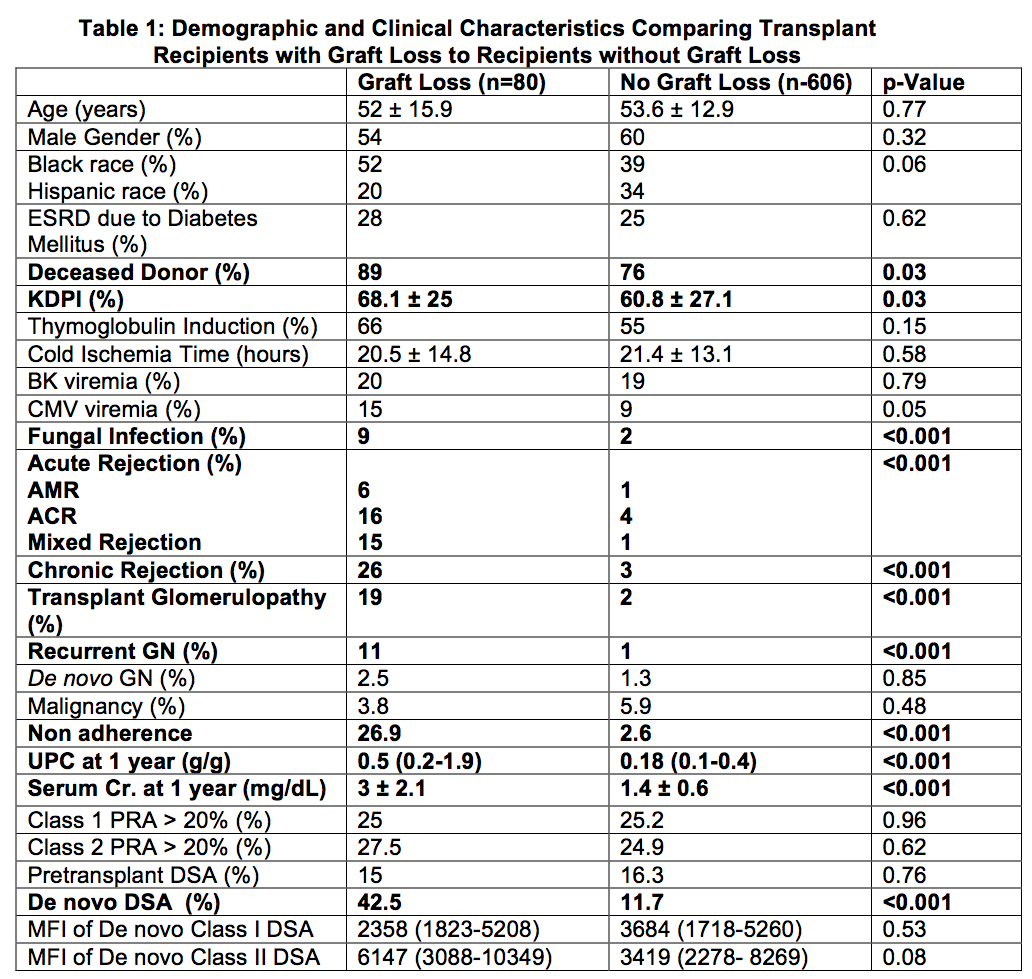Predictors of Graft Loss in an Urban Predominantly Minority Cohort of Kidney Transplant Recipients.
Monterfiore/Einstein Center for Transplantation, Bronx, NY
Meeting: 2017 American Transplant Congress
Abstract number: D260
Keywords: Graft function, Graft survival, Kidney transplantation, Outcome
Session Information
Session Name: Poster Session D: Long Term Kidney Outcomes
Session Type: Poster Session
Date: Tuesday, May 2, 2017
Session Time: 6:00pm-7:00pm
 Presentation Time: 6:00pm-7:00pm
Presentation Time: 6:00pm-7:00pm
Location: Hall D1
Background
We aimed to determine the demographic and clinical characteristics associated with graft loss in a cohort of kidney transplant recipients with a high African-American and Hispanic population.
Methods
We performed a retrospective review of all patients who received a kidney transplant from 1/1/09 to 12/31/14. Patients who died with a functioning allograft were excluded. Demographic and clinical characteristics of patients who lost their grafts were compared to patients who had allograft function at the end of the study period.
Results
A total of 686 patients with 41 % African-American and 32.5% Hispanic were included in our analyses. During a median follow-up of 3.8 (2.4-5.3) years, 80 (11.7%) lost their allografts at a median time of 1.8 (0.38-3.5) years. The demographic and clinical characteristics which did not differ are shown.  Graft loss was significantly associated with a deceased donor (89% vs. 76%), a higher KDPI (68.1 ± 25% vs. 60.8 ± 27.1%), fungal infections (9% vs. 2%), acute (37% vs. 6%) and chronic rejection (26% vs. 3%), recurrent glomerular disease (11% vs. 1%) and non-adherence (26.9 vs. 2.6 %). Proteinuria at one year and increased creatinine were also significantly associated with graft loss. Class 1& 2 de novo DSA developed in 35% and 27.5% with graft loss and 8.6% and 5.1% without graft loss respectively. Multivariate logistic regression demonstrated that non-adherence, urine protein:creatinine ratio at 1 year; serum creatinine at 1 year, development of de novo DSA and acute rejection were independent predictors of graft loss.
Graft loss was significantly associated with a deceased donor (89% vs. 76%), a higher KDPI (68.1 ± 25% vs. 60.8 ± 27.1%), fungal infections (9% vs. 2%), acute (37% vs. 6%) and chronic rejection (26% vs. 3%), recurrent glomerular disease (11% vs. 1%) and non-adherence (26.9 vs. 2.6 %). Proteinuria at one year and increased creatinine were also significantly associated with graft loss. Class 1& 2 de novo DSA developed in 35% and 27.5% with graft loss and 8.6% and 5.1% without graft loss respectively. Multivariate logistic regression demonstrated that non-adherence, urine protein:creatinine ratio at 1 year; serum creatinine at 1 year, development of de novo DSA and acute rejection were independent predictors of graft loss.  Conclusions
Conclusions
Non-adherence is a strong independent predictor for graft failure in our predominantly African-American and Hispanic population. Efforts to increase adherence and decrease acute rejection rate and development of de novo DSA might improve graft survival.
CITATION INFORMATION: Hayde N, Kamal L, Ajaimy M, Lubetzky M, Bedi P, de Boccardo G, Akalin E. Predictors of Graft Loss in an Urban Predominantly Minority Cohort of Kidney Transplant Recipients. Am J Transplant. 2017;17 (suppl 3).
To cite this abstract in AMA style:
Hayde N, Kamal L, Ajaimy M, Lubetzky M, Bedi P, Boccardo Gde, Akalin E. Predictors of Graft Loss in an Urban Predominantly Minority Cohort of Kidney Transplant Recipients. [abstract]. Am J Transplant. 2017; 17 (suppl 3). https://atcmeetingabstracts.com/abstract/predictors-of-graft-loss-in-an-urban-predominantly-minority-cohort-of-kidney-transplant-recipients/. Accessed January 7, 2026.« Back to 2017 American Transplant Congress
